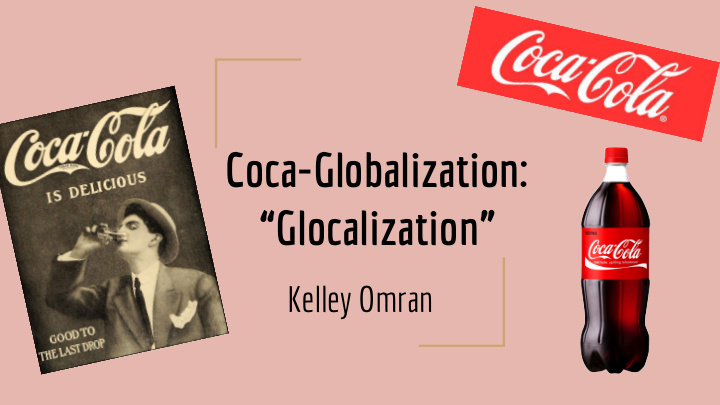



Coca-Globalization: “Glocalization” Kelley Omran
About the Author: Robert J. Foster - B.A. in Anthropology from the University of Chicago in 1979 - M.A. in Anthropology at Columbia University in 1982 - PhD in Anthropology at the University of Chicago in 1988 - Currently a Professor of Anthropology and Visual and Cultural Studies at the University of Rochester in New York - Research interests: Political economy, material culture, globalization, corporations, commercial media, and mobile phones
Coca-Cola’s Globalization - Economic and cultural globalization: - Makes the world smaller - Corporations have hypermobility and - Coca-Cola: among the first consumer-oriented, brand-invested placelessness and are multinational symbol of corporate unanchored to any locality, global culture and have the ability to - While multinational, it is also a search the world for cheap nationalistic icon of the United labor and raw materials States
Relationship between the global & the local How did The Coca-Cola Company attempt to localize a distinctively American drink in foreign contexts? - Roland Robertson argued that globalization and localization aren’t opposites, but rather we should pay attention to the “way in which homogenizing and heterogenizing tendencies are mutually implicative” (page 34) → glocalization - Disembedding and reembedding: the consumer item leaves its local context and is inserted into new and different localized contexts, in order to become part of a commodity network - Global culture: organized diversity, Local culture: diversity through a translocal framework
Coca-Cola’s Journey Towards Globalization - 1906: opened a plant in Havana - 1926: Coca-Cola President Robert Woodruff established a foreign department - Company technicians found a way to condense syrup into a more easily shipped powdered concentrate without sugar → saved resources and money - 1927: replaced the foreign department with The Coca-Cola Export Corporation because they were planning to build facilities worldwide to manufacture concentrate - 1930: more than 60 bottling plants operated in 28 different countries - Period of World War II : operations in South America, Australia, Asia, Canada, and Europe → war accelerated Coca-Cola’s transition into a multinational business
Utopian Internationalism
1971 Coca-Cola Ad: “I’d Like to Buy the World a Coke”
The Franchise System - 1950: Coca-Cola Export Company’s goal: make Coca-Cola an integral part of people’s everyday lives, to weave the product into the “pattern and customs of every land” - ⅓ of profits came from foreign business - Results: - Deliberate localization and imperial conquest - Ran campaigns emphasizing that the whole process, including production and distribution, is done from the country that they are being promoted towards - Bottling partnerships - 1955 Fanta Orange in Italy - Transition from glass bottles to cans to plastic bottles
1950s “The Drink of Friendship” ad campaign “If U.S. origin companies can become multi-local, and can integrate around the globe economically without people feeling that they are being culturally assaulted, they will be successful” - Friedman, page 58
More History - By 1972, 75% of Coca-Cola’s earnings are from abroad - In the end of the 20th century, it increased to 80%, at $3 billion - → Showed importance of Coca-Cola’s overseas operations. Moved Export’s headquarters from NY to ATl in 1972 - Changed leadership: Roberto Goizueta
Roberto Goizueta - New CEO of The Coca-Cola Company in May 1980 - Increased control over how products were bottled/marketed around the world - $13 million in Philippine bottler, the San Miguel Brewery → success, huge lead over their rival, Pepsi - “Coca-colonized” the international bottling system - “People around the world are today connected to each other by brand-name consumer products as much as by anything else” page 63 - Convergence of consciousness → how Coca-Cola succeeds universally - Global expansion of soft-drink consumption: Places with insufficient/poor quality drinking water = higher demand → war against tap water, or transformation of tap water from an end product to an ingredient
Trust and Anti-Trust - Trust - Peru: Inca-Kola was acquired by The Coca-Cola Company - Germany: Where Fanta Wildberries were conceived, developed, and produced - Anti-Trust - Belgium: scare about contaminated cans of Coca-Cola → largest product recall in company history
128 Years of Coca-Cola’s History
Discussion Questions Does Coca-Cola have an obligation to be socially ethical considering their globalized platform? What are the benefits and downfalls of a company utilizing glocalization vs. just localization?
Recommend
More recommend